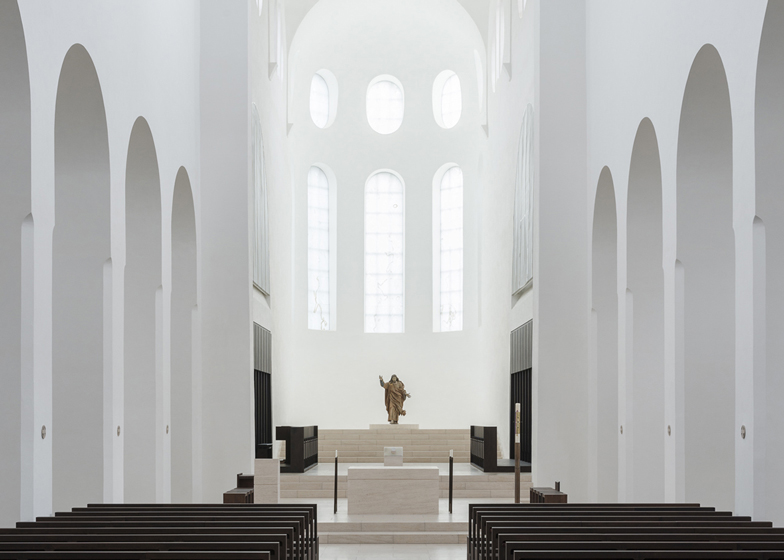British architect John Pawson's minimalist remodelling of a church in Augsburg, Germany, includes slices of onyx over the windows to diffuse light more softly through the space.
Slices of finely veined translucent white stone were laminated to glass and installed in the choir windows. "The effect of this is to generate the optimum light conditions, screening out direct sunlight and bathing the space in a haze of diffused luminescence," John Pawson architects explained.
Update 1/08/2013: the Architects Registration Board has written to Dezeen to point out that Pawson is not a registered architect and has given us 14 days to amend this story
The apse is the brightest space in the church, followed by the nave where the altar sits on a new podium. Lighting in the side aisles is more subdued, where clerestory windows and carved sculptures of the apostles maintain links to the church's Baroque past.
At night the illumination comes from LED lights concealed in the choir apse, at the base of columns in the nave and in rings round the cupola domes overhead.
The floor and altar are finished in Portuguese limestone, while the dark stained wood of the pews, choir stalls and organ provides a strong contrast with the otherwise pure white interior.
The St Moritz Church was founded nearly 1000 years ago and has been transformed many times over by fire, changes in religious practice and bombing. After the Second World War only the baroque outer walls remained and the church was rebuilt by German architect Dominikus Böhm in a simplified post-war style.
"The work has involved the meticulous paring away of selected elements of the church’s complex fabric and the relocation of certain artefacts to achieve a clearer visual field," said the architects.
John Pawson is celebrated for his minimalist architecture and the firm was asked to renovate the church after the parish councillors visited his Novy Dvur monastery in the Czech Republic.
The studio is also currently working on the new Design Museum in the former Commonwealth Institute building in west London and 26 high-end apartments for a new leisure complex at Miami Beach.
See more architecture by John Pawson »
See more church design »
Photographs are by Gilbert McCarragher.
Here's some more information from the architects:
The church of St Moritz has been through many changes since its foundation nearly a thousand years ago. Devastating fires, changes in liturgical practice, aesthetic evolution and wartime bombing have each left their mark on the fabric of the building. The purpose of this latest intervention has been to retune the existing architecture, from aesthetic, functional and liturgical perspectives, with considerations of sacred atmosphere always at the heart of the project.
The work has involved the meticulous paring away of selected elements of the church’s complex fabric and the relocation of certain artefacts to achieve a clearer visual field. Drawing on existing forms and elements of vocabulary, an architectural language has evolved that is recognisable in subtle ways as something new, yet has no jarring foreign elements.
St Moritz is laid out according to the clear linear principles of a Wegekirche and this spatial character, with its strong forward focus on the apse, is retained and reinforced in the current re-ordering, with the eye purposefully drawn through the nave to the apse, which is designed as a room of light, heralded by the Baroque sculptor Georg Petel’s figure of Christus Salvator.
A key gesture of the intervention is the quiet transformation of the apse windows, which must function architecturally as a source of light and liturgically as an expression of the threshold to transcendence. The existing glass is replaced with thin slices of onyx. The effect of this is to generate the optimum light conditions, screening out direct sunlight and bathing the space in a haze of diffused luminescence.
The treatment of the apse windows represents the culmination of a wider strategy for light, whose aim is to achieve a clear distribution of light, with the apse as the brightest area in the church. After the apse, the area of the nave where the liturgy is performed is brightest, whilst the side-aisles revert to more subdued light conditions. The Baroque clerestory windows, relieved of their former function of illuminating the artwork and decoration, now serve as indirect sources of light.
In line with the requirements of the Second Vatican Council, the altar is relocated to a newly created island in the nave, bringing the liturgy closer to the congregation and making it possible to site the principal liturgical landmarks - the altar, the ambo and the sedilia - on a single level.
Project: interior remodelling, St Moritz Church
Location: Augsburg, Germany
Client: Diocese of St Moritz
Executive architect: Rainer Heuberger
Project architects: Jan Hobel, Reginald Verspreeuwen
Structural engineer: Dr. Schütz Ingenieure
Mechanical engineer: Ingenieurbüro Ulherr
Electrical engineer: Electro Seitz, Gattinger
Lighting design: Mindseye, Fa. Sonepar
Acoustic consultant: Müller BBM
Project manager: NPS Bauprojektmanagement
Completion: April 2013

